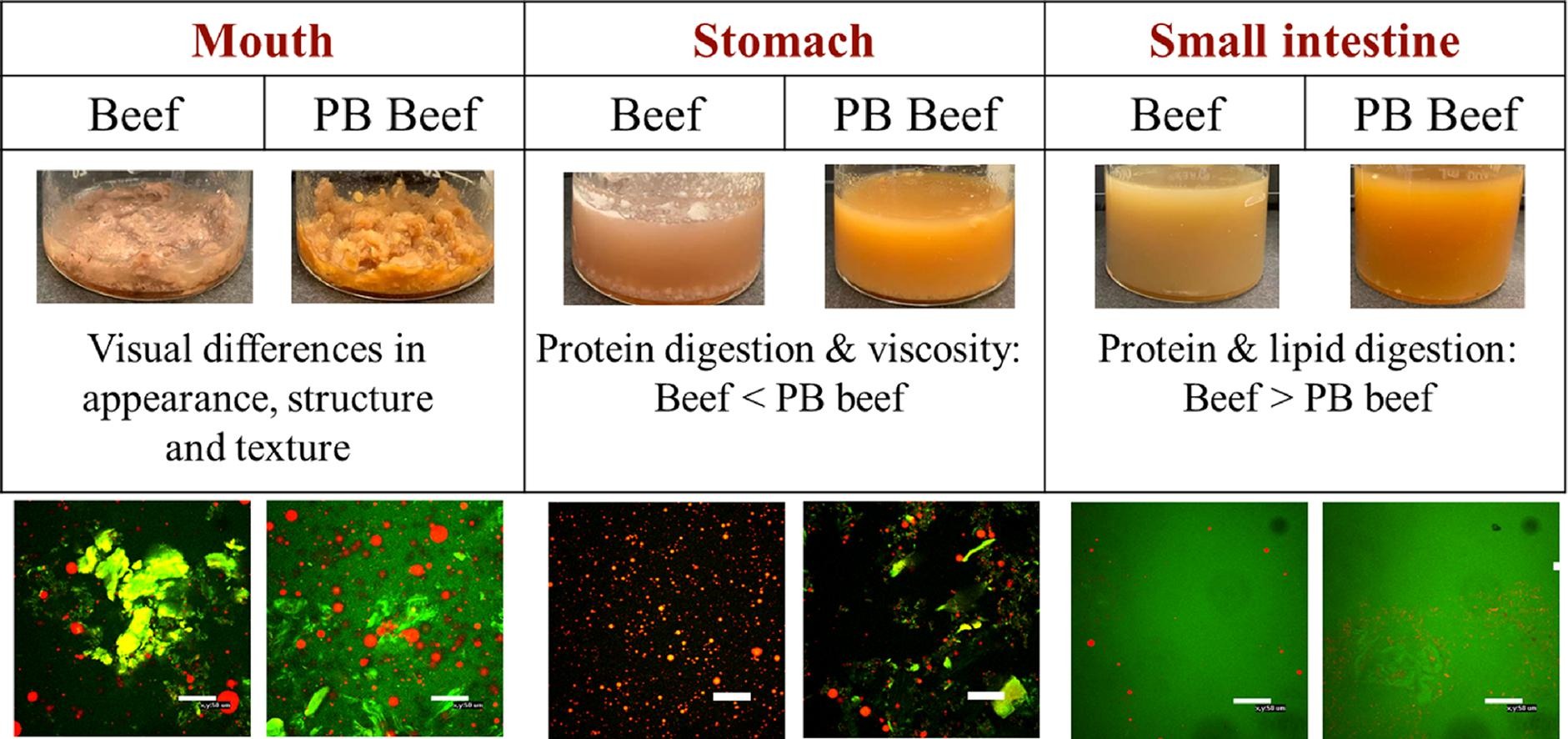The creation of plant-based foods and their gastrointestinal fate
Introduction
The plant-based (PB) food, as one of the next-generation foods, have been increasingly adopted by consumers because they are more sustainable, environment-friendly, and have less ethical concerns. To increase their nutrition and quality, we applied food nanoemulsion to fortify plant-based milks with vitamins, calcium, and polyphenols. We also used the curcumin-nanoemulsions and RuBisCO protein as the basic plant ingredients, to develop the plant-based eggs by mimicking the appearance and gelation properties of real eggs. Besides the food designs, we explored the potential gastrointestinal fate of PB foods. For example, we studied the effects of calcium forms and levels on the vitamin bioaccessibility in plant-based milks. We also characterized the difference between PB and real beef meat, particularly for the changes of physicochemical properties and effects on the lipid and protein digestion, and developed standardized methods to assess the PB meats.
Main findings
- Fortifying plant-based milks [1,2]
Many plant-based milks lack key micronutrients found in bovine milk, such as calcium and vitamin D. We fortified almond milk with these two micronutrients and used a standardized gastrointestinal model to examine the impact of product formulation on their bioaccessibility. We found that high levels of calcium (soluble or insoluble) reduced vitamin D bioaccessibility, which was attributed to insoluble calcium soap formation in the small intestine. Calcium bioaccessibility was higher for CaCO3 than CaCl2.

We also fortified the PB milks (such as almond, cashew, coconut, and oat) with the curcumin, and found that these PB milks can be considered as promising delivery systems to encapsulate and deliver the curcumin. Curcumin had a high encapsulation efficiency (>86%) in all milk analogs, which was attributed to its solubilization inside the oil bodies. The curcumin-loaded plant-based milks had fairly similar bioaccessibilities (>60%), which were much higher than those seen for a crystalline form of the curcumin (about 5%).
- The development of standardized methods to assess plant-based meats [3,4]
We proposed standardized testing protocols to characterize important physicochemical attributes of beef burgers and their plant-based (PB) analogues, including appearance, cooking loss, water holding capacity, and textural profile, which can be used to quantify the changes in the quality attributes of plant-based meat analogues when they are cooked and to establish the similarities and differences of their physicochemical attributes to real meat products. The protocols are relatively simple to perform and provide quantitative data for the assessment. Their efficacy was established by measuring and comparing the physicochemical properties of 10 commercial real and PB beef burgers. A principal component analysis model showed appreciable differences in the cooking loss and texture profile properties, indicating that further research is still required to create high-quality PB meat products.

We also used standardized INFOGEST in vitro digestion method to assess the digestibility and gastrointestinal fate of real meat versus PB meats, focusing on differences in microstructure, physicochemical properties, lipid digestion, and protein digestion in different regions of the model gut. The presence of dietary fibers in the beef analogs increased their apparent shear viscosity in the gastrointestinal fluids, which may have inhibited lipid digestion in the small intestine. The proteins in the beef analogs were digested more rapidly in the stomach but less rapidly in the small intestine.

- Plant-based eggs
We used plant-based RuBisCO protein and curcumin-loaded nanoemulsions to create the plant-based eggs, this work is still in the progress.
Publications
[1]. Zheng, B.#; Zhou, H.#; McClements, D. J., Nutraceutical-fortified plant-based milk analogs: Bioaccessibility of curcumin-loaded almond, cashew, coconut, and oat milks. LWT 2021, 147, 111517. DOI
[2]. Zhou, H.; Zheng, B.; Zhang, Z.; Zhang, R.; He, L.; McClements, D. J., Fortification of Plant-Based Milk with Calcium May Reduce Vitamin D Bioaccessibility: An In Vitro Digestion Study. Journal of Agricultural and Food Chemistry 2021, 69 (14), 4223-4233. DOI
[3]. Zhou, H.; Hu, Y.; Tan, Y.; Zhang, Z.; McClements, D. J., Digestibility and gastrointestinal fate of meat versus plant-based meat analogs: An in vitro comparison. Food Chemistry 2021, 364, 130439. DOI
[4]. Zhou, H.; Vu, G.; Gong, X.; McClements, D. J., Comparison of the Cooking Behaviors of Meat and Plant-Based Meat Analogues: Appearance, Texture, and Fluid Holding Properties. ACS Food Science & Technology 2022, 2 (5), 844-851 DOI
Presentations
[1]. Zhou, H., Fortification of plant-based milk with calcium may reduce vitamin D bioaccessibility: an in vitro digestion study. 2021, Poster presentation at Institue of Food Technologist 2021 Annual Meeting.
[2]. Zhou, H., RuBisCO proteins as plant-based alternatives to egg white proteins: Characterization of thermal gelation properties. 2022, Poster Presentation at 2022 AOCS Annual Meeting & Expo, Atlanta, GA, May 1-4.
[3]. Zhou, H., The application of plant-based emulsions in the development of egg analog. 2022, Oral presentation at Next Generation Plant-based Foods Symposium, Department of Food Science, University of Massachusetts, Amherst, April 20th 2022.
